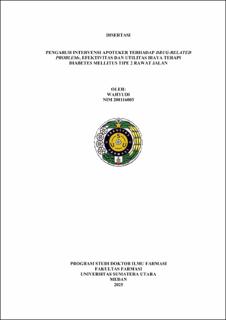Pengaruh Intervensi Apoteker Terhadap Drug-Related Problems, Efektivitas dan Utilitas Biaya Terapi Diabetes Mellitus Tipe 2 Rawat Jalan
The Impact of Pharmacist Intervention on Drug Related Problems, Effectiveness and Cost Utility of Outpatients with Type 2 Diabetes Mellitus

Date
2025Author
Wahyudi, Wahyudi
Advisor(s)
Nasution, Azizah
Lindarto, Dharma
Khairunnisa, Khairunnisa
Metadata
Show full item recordAbstract
Type 2 diabetes mellitus (T2DM) is a global health problem with a prevalence of 643 million people in 2030. Pharmacist intervention (PI) in hospitals is important for T2DM outpatients to reduce drug-related problems (DRPs) and increase cost-effectiveness and cost-utility. Aim of this study was to analyze the impact of PI on DRPs, cost-effectiveness and cost utility in T2DM outpatients. This quasi-experimental retrospective and prospective study was conducted for six months on 106 T2DM outpatients at the Prof. Dr. Chairuddin P. lubis (CPL) Hospital who met the inclusion criteria and were recruited using random sampling techniques. Drug Related Problems (DRPs) were analyzed by Pharmaceutical Care Network Europe (PCNE) V9.1, clinical condition of the patients, laboratory results, and trustable literatures. Clinical outcomes described are HbA1C values. Direct medical costs were obtained from the CPL Hospital finance department and patient quality of life (QoL) applying the Euro Quality of Life 5- Dimension 5 -level (EQ5D5L). This pharmacoeconomic study calculates the value of cost-effectiveness ratio (CER), incremental cost-effectiveness ratio (ICER), quality adjusted life years (QALY), cost utility ratio (CUR), incremental cost-utility ratio (ICUR) and cost-consequences. The results showed that PI reduced 22.05% DRPs (p-value <0.001), increased 14.15% the number of patients with optimal HbA1C (p-value 0.000), reduced 11.89% direct medical costs (p-value 0.667), cost effective (ICER -385,816.72), and cost utility (ICUR -12,845,427.30). PI could reduce the incidence of DRPs and cost-effective and cost-utility in T2DM outpatients.
